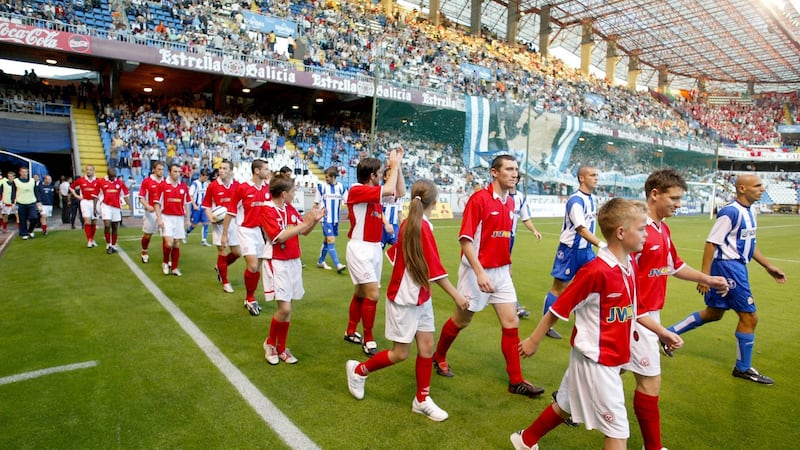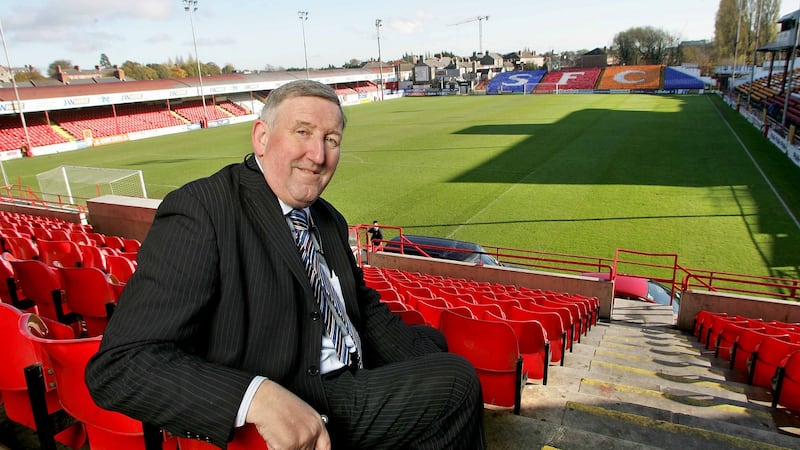Almost a decade to the day after his death, the financial wreckage of Ollie Byrne’s past ambitions for Shelbourne have finally been cleared up.
As the team prepare for their cup tie on Friday night against Shamrock Rovers – the sort of game Byrne would have relished – the club’s current board is looking for new investors with the resources required to move it forward again.
Meetings have taken place in recent weeks with a number of interested parties but nobody has committed yet to the sort of sum the club’s current officials have in mind. One estimates that an initial investment of €500,000 followed by a similar sum again over a couple of years would be required to get Shelbourne back into the top flight and, potentially, competing for a place in Europe again.
Byrne, of course, famously targeted a place in the Champions League group stages and the club came within a game of achieving it in 2004 when they were beaten in the final qualifying round by Deportivo La Coruna. However, the company behind Shelbourne made a loss of €1.7 million that year alone and when a final list of creditors was compiled a few months ago as part of the process of liquidating the company, its total liabilities stood at €4.4 million. But even that didn’t tell the full story.

Knowing they had no chance of recovering anything, a number of creditors chose to write their money off and walk away rather than feature in the final list. And while roughly three quarters of the money Accolade Limited still officially owed was due to the two companies that had been behind the proposal to redevelop Tolka Park, Byrne had also borrowed large amounts from less orthodox sources.
Dealing with additional debts of around €2.5 million that had been accumulated by Byrne complicated what was already a daunting challenge for the board after his death. That has now been achieved, says current chairman Joe Casey, with the passing of so much time contributing to a realisation on all sides that there was very little really in the pot to fight over.
Casey himself is listed as having been owed €350,924 by Accolade, the largest amount recorded as having been due to an individual. John Courtney, a well known figure within the Irish game over many years due to his ownership of the Umbro brand in Ireland – since taken over by his son – lost €138,000 with the late Joe White having lost €130,000.
The rest of Accolade’s debts are very much the sort of mix that might be expected in the circumstances with individuals associated with the club and well known commercial goods and service providers amongst those to feature in the list of creditors.
The development companies that funded such a significant part of Shelbourne’s spending, meanwhile, ended up in Nama with bank loans at the end of 2015 of some €3.88 million. Their accounts suggest Anglo Irish Bank provided most of the €5.6 million or so that they either advanced to the club directly or used to fund the purchase of the Tolka Park lease that was at the heart of their proposed redevelopment deal. In effect, it seems, we all chipped in a little towards Ollie Byrne’s pursuit of success.
Amid the chaos that engulfed the club in the wake of Byrne’s death, a small group of directors stayed on to try to sort out the mess. The particular nature of the situation may have made a more open relationship with the club’s support base difficult but there have certainly been tensions and a boycott by a small number of fans continues.

With the problems resolved Casey is hopeful that a greater level of unity can be achieved, although he remains opposed for the moment, at least, to the notion of a fan owned club – a route favoured by many of the most active supporters.
“We feel that if we go down that road we will negate any chance of getting investors,” he says. “We may end up having to go down that road but we don’t have the fanbase of Cork, we don’t have the fanbase of Rovers so the money that they would bring in would not be enough to get us out of where we are at the moment (the wilderness of the first division).
“That’s why we would like to see an investor come in. Not the sort of investor that has gone to Athlone. Somebody who has the league at their heart.”
After such turbulent times, the club is now remarkably stable, Casey says. From a weekly wage bill of €37,000 at the time of that fabled European campaign, there is now a budget of just under €3,000 for players with virtually nobody else at the club getting paid for anything. Current turnover is somewhere between €250,000 and €275,000 per annum and the club, having broken even in each of the last seven seasons, is – with the demise of Accolade and the consignment to history of so much else – finally debt free.
"What we have to offer," suggests long time board member Colm Murphy, "is something quite special in one way because we have a club with no debt, we have a well known brand – albeit a tarnished one – and we have the prospect of security of tenure where a stadium is concerned."
This last point refers to the deal done with Dublin City Council under which Shelbourne are scheduled to relocate to Dalymount Park – where they will groundshare with Bohemians – by 2022.
Funding for the redevelopment of Dalymount has yet to materialise, however, and with the latest estimate of what the new ground is set to cost put at either €32 million or €36 million, depending on who you talk to, the timeframe or even the entire project as it is currently envisaged, might yet prove ambitious.
Casey, though, believes that there is still something at Shelbourne to attract someone with a love of the game and the wealth required to rejuvenate the club.
“There’s no property play here, anyone who comes in here, it will be for the club,” he says with the air of a man who has endured a good deal over the past decade. Yet he somehow retains an enthusiasm for the dream sold to him by Byrne during their first ever conversation over a lunch in Fagan’s – by the end of which Casey had been recruited to the board.
“Or to see if they can turn a buck if they are prepared to speculate. There’s a much bigger chance of an Irish club getting into Europe than there is of 95 per cent of the clubs in England . . .”















